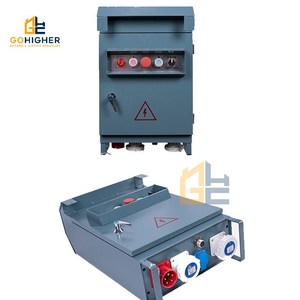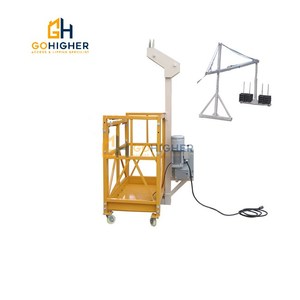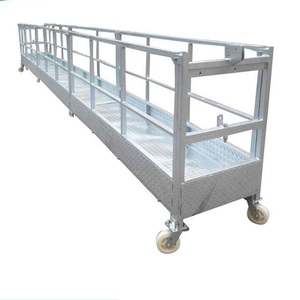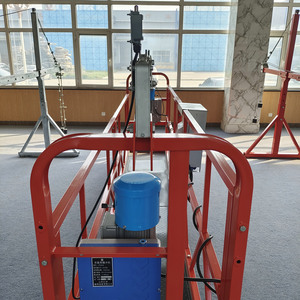(1453 products available)

































































































































































































































Swing stage scaffolding is a temporary platform used in construction to support workers and materials. It is an essential equipment piece for many construction, maintenance, and inspection projects. There are several types of stage scaffolding, including the following;
Single swing stage
A single swing stage is a scaffold platform that has its support beams, rods, or cables anchored above. The stage is suspended from the building or structure being worked on. This type of swing stage scaffolding is mostly used in building, maintenance, and repair projects. It is ideal for tasks that need to be done on the walls or façades of high structures. Since the single swing stage has its support above, it provides workers with easy access to elevated surfaces. It is safer than using ladders. The single swing stage is commonly used when working on high-rise buildings. It is the go-to choice for projects requiring access to vertical spaces.
Double swing stage
A double swing stage is a type of swing stage scaffolding with two platforms. It is a complex structure than the single swing stage. The double swing stage is supported by two sets of suspension cables or beams. These cables or beams are attached to the building or structure being worked on. The double swing stage is ideal for larger projects that need more space. Its design makes it suitable for tasks that need to be done on double-sided walls or high structures. It can hold more weight than the single swing stage, making it safer for large maintenance or construction tasks.
Mini swing stage
A mini swing stage is a small-sized scaffolding platform. It is designed for smaller tasks or tight spaces. The mini swing stage can be swung out to give workers access to elevated surfaces. It is commonly used in construction and maintenance projects needing a small platform. The mini swing stage is ideal for projects done on small structures. It is also great for maintenance tasks in cramped spaces. Its small size makes it suitable for tasks in tight or limited spaces.
Swing stage scaffolding has numerous applications in construction. Its features enable construction personnel to conduct their activities efficiently and safely.
Help Building High-Rise Structures
Swing stage scaffolding is essential in the construction of high-rise buildings. The platform is adjustable, allowing construction workers to build high-rise structures. Workers can raise swing scaffolds to the desired height to build tall buildings.
Installation and Maintenance
Stage scaffolds are also crucial for installing and maintaining building components. The adjustable swing scaffolds provide a stable platform for workers to install windows, HVAC systems, and electrical wiring. The swinging motion helps position workers at different angles for proper installation. Scaffold also facilitates component maintenance. Workers can easily access building parts and perform maintenance tasks.
Painting and Finishing
Another significant function of swing scaffolds is painting and finishing high-rise structures. The adjustable platform allows construction personnel to reach all building areas, ensuring a uniform paint job. Stage scaffolds also enhance accessibility, allowing workers to apply finishes to intricate surfaces.
Exterior Cleaning
Stage swing scaffolding is crucial in cleaning the exteriors of high-rise buildings. The platform allows cleaning personnel to access the entire building surface and perform cleaning tasks efficiently.
Inspection
Swing scaffolds provide a stable and safe platform for inspectors. They can inspect the exterior of high-rise buildings and identify any structural issues or maintenance needs.
Feature
Adjustability
Swing stage scaffolding is adjustable. It can be raised to different heights and swung to various angles. This helps construction workers reach different parts of the building efficiently.
Stability
Swing scaffolds are stable. They remain steady when swung to different positions, providing a safe working environment for construction workers.
Safety features
Swing stage scaffolds have safety features such as guardrails, safety harness attachment points, and anti-sway devices. These safety features help prevent falls and ensure worker safety.
Swing stage scaffolding is extensively used in various industries and applications, particularly for construction, maintenance, and renovation projects involving tall buildings or vertical structures. Here are some common usage scenarios:
Building Construction:
Stage scaffolding is used to provide access to exterior walls and facades during the construction of high-rise buildings, commercial structures and skyscrapers. They enable workers to safely and efficiently perform tasks such as installing windows, brick-laying and applying exterior finishes.
Building Maintenance and Cleaning:
These scaffolds are used to clean and maintain the facade of skyscrapers and other tall structures. They are also used for routine maintenance tasks such as painting, repairs and inspections. This helps to improve and maintain the structural integrity and aesthetic appearance of the building.
Building Renovation and Repairs:
They are commonly used during renovation projects on stage buildings. They provide safe access to workers to carry out tasks such as facade restoration, window replacement and structural repairs. This is done especially on historical or tall buildings.
High-Rise Construction Projects:
Swing stage scaffolding is a common sight at high-rise construction sites. They allow workers to access and work on multiple floors, ensuring efficient construction of skyscrapers and high-rise residential buildings.
Facade Inspections:
These scaffolds are used in inspecting the facade of tall buildings. They allow inspectors to closely examine the structural integrity of the building and potential issues such as cracks or loose debris. This ensures safety of occupants and building itself.
Bridge and Tunnel Construction:
Swing stage scaffolding can be used in constructing and maintaining large-scale infrastructure projects like bridges and tunnels. They provide access to workers to safely perform tasks in high and hard-to-reach areas.
Wind Turbine Installation:
These scaffolds are used in installing and maintaining wind turbines. They provide access to workers to safely work on large turbine blades and towers at heights.
Oil and Gas Industry:
Swing stage scaffolding is used in the oil and gas industry for maintenance and inspection of large equipment and structures such as storage tanks and drilling rigs. They ensure workers can safely access these structures at heights.
When choosing the right swing stage scaffolding, there are a number of things that must be considered. Here are some of them:
Nature of the Project
The first thing that should be considered is the nature of the project. This entails looking at the type of construction work that needs to be carried out and determining the right scaffolding swing stage to go for. For instance, if the project involves working on a high-rise building, then a robust and adjustable swing stage scaffolding would be ideal.
Safety Features
Another important thing to consider when choosing swing stage scaffolding is safety. It is important to ensure that the swing stage scaffolding comes with all the necessary safety components. This includes but is not limited to; reliable safety harnesses, strong guardrails, anti-slip platforms, and secure locking mechanisms.
Quality
The material used to manufacture swing stage scaffolding determines its durability and strength. Therefore, it is important to ensure that the swing stage scaffolding is made from high-quality materials. Ideally, look for scaffolding swing stages that are manufactured using high-grade galvanized steel or aluminum.
Load Capacity
Workmanship and swing stage scaffolding come with different load capacities. As such, it is important to determine the weight that will include the tools and materials to ensure that the swing stage scaffolding can support the weight comfortably. Choosing scaffolding that can comfortably support the total weight ensures the safety of everyone involved.
Adjustability
Some construction projects require scaffolding to be in different positions and angles. As such, it is important to choose swing stage scaffolding that is adjustable to meet the requirements of the project. This not only enhances efficiency but also ensures that the scaffolding is safe regardless of the angle or position it is in.
Compliance
All types of scaffolding are required to meet certain safety standards and regulations. This is to ensure the safety of everyone involved. As such, it is important to ensure that the swing stage scaffolding chosen complies with the relevant local and international standards.
Q1. What are the safety requirements for swing stage scaffolding?
A1. All safety requirements for swing stage scaffolding are contained in the ANSI/SC150 Standard for Safety Requirements for Swing Stage Scaffold. The standard outlines the construction, load requirements, and safety features of the swing stage.
Q2. How does swing scaffolding work?
A2. Swing stage scaffolding is hung from the roof or building over the stage. The scaffolding has pulleys that help it move up and down. Workers control the pulleys with a machine. Safety cables keep the scaffolding from falling in case the pulleys break.
Q3. What are the disadvantages of swing stage scaffolding?
A3. The main disadvantage of stage swing scaffolding is that it can only be used on buildings or structures without obstacles. If there are no obstacles, the scaffolding may not stay balanced. It also requires a roof or strong structure to hold the scaffolding and cannot be used on all types of jobs.
Q4. How much weight can swing-stage scaffolds hold?
A4. According to safety standards, a swing stage scaffold can safely hold its weight plus four times its weight in additional material and workers. This means if the scaffold weighs 1,000 pounds, it could safely hold 4,000 pounds total.
Q5. Who can use swing-stage scaffolds?
A5. Only trained workers with special certifications are allowed to use swing-stage scaffolds. This ensures everyone knows the safety rules and how to operate the scaffold equipment safely.